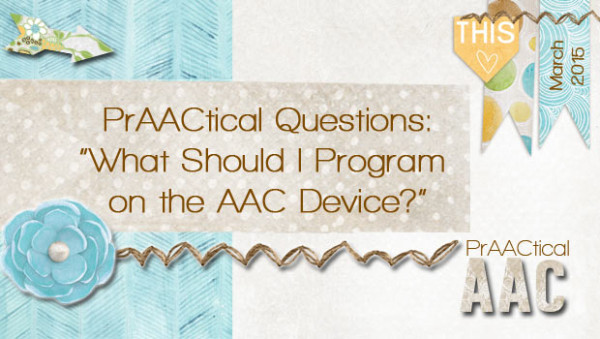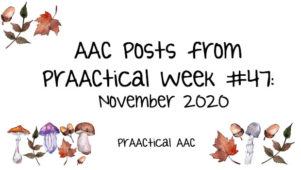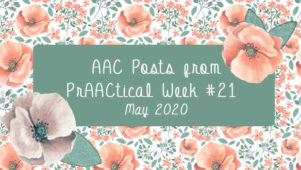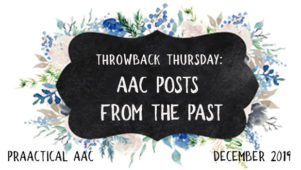PrAACtical Questions: “What Should I Program on the AAC Device?”

“My client has a new SGD and will begin bringing it to school. What words should I program on it?”
We are so fortunate to be practicing at a time when the high tech SGDs and robust AAC apps come pre-loaded with lots of vocabulary. Still, when you sit down to prepare the device for an actual client, it can be hard to determine what needs to be there right away and what can wait. You’ll find lots of forms and checklists floating around, some for children and some for adults. There are lots of right ways to do this. In making these decisions, I typically run through a mental checklist of a few categories, thinking both about single words and longer messages.
Single Words
Core Vocabulary: In most cases, we’ve selected an AAC tool that has ample core words to choose from. Use what you know about normal language development to guide your decision about which specific core words to include in the early stages of device use. Then, the question becomes “How much vocabulary should we start with?” Start with more than what the client currently knows. More than what you are teaching right at the moment. To move them forward, we have to go beyond what our clients have now and begin giving them experiences with new words. Not sure what your client knows? In general, it’s better to overshoot than undershoot when determining how much vocabulary to provide.
Fringe Vocabulary: Unlike core vocabulary, these are generally nouns that are highly specific to the individual learner. It usually includes things like:
- Names of family members, teachers, friends, therapists, and pets
- Places they frequent
- Favorite things they do or like
Phrases and Sentences
Participation Messages: Participation messages are those things that a learner needs to say to participate in their daily environments. Looking at what peers say is the best source of information. Get specific. “What do students in Ms. Herrera’s class need to say in order to fit in?” It could be things like The Pledge of Allegiance, the Morning Message Chant, names of classroom jobs, etc. It could also be silly or annoying (but totally age-appropriate) messages like “Yer mom!” or “Shake it off!”
Time-sensitive Messages: These are things that need to be expressed quickly, like requests for the bathroom, indications of pain, or signals that a seizure is approaching. This category also includes social messages (e.g., “Hey! How’s it going?” “Did you do the homework?”), repair messages (e.g., “That’s not what I meant.” “Can you explain?”), transaction messages (e.g., “I have something to say, but it’s not in my device.” “Ask me a yes/no question about it.”), and academic activity messages (e.g., “I know that one!” “Will you be my partner?”).
Independence Messages: This category includes anything that the learner needs help with (e.g., “Can you get my book out of my backpack?” “My lunch card is in my pocket.” “I need my food chopped, please.”) and things that build self-advocacy skills (e.g., “Can I have a turn?” “That doesn’t seem fair.” “I don’t agree.” “I can’t see from here.”).
Once we have messages in each of those areas I do a few more “checks.” One is for communicative functions. I try to look to see if I’ve included enough messages in each category of communicative functions (e.g., comments, greeting/leave-taking, asking, showing off, protesting, answering, attention-seeking, requesting). I also try to run through our areas of communicative competence: linguistic, social, strategic, and operational. Did I overlook messages for any of these areas? This is the time for fine-tuning.
Finally, a reminder that vocabulary selection is a team sport. We don’t know these learners half as well as their teachers and aides do, let alone their families. Get input from all of them right from the start. Why? Because they know things that we don’t. Plus, they will be our allies in implementation. Don’t we all have more ‘buy-in’ when we are included in the decision-making as opposed to when someone just hands us something and tells us to do it? We can’t fly solo on something this important, so reach out and get help from families and colleagues. It’s the prAACtical thing to do.
Filed under: PrAACtical Thinking
Tagged With: SGD, teaming, vocabulary
This post was written by Carole Zangari




